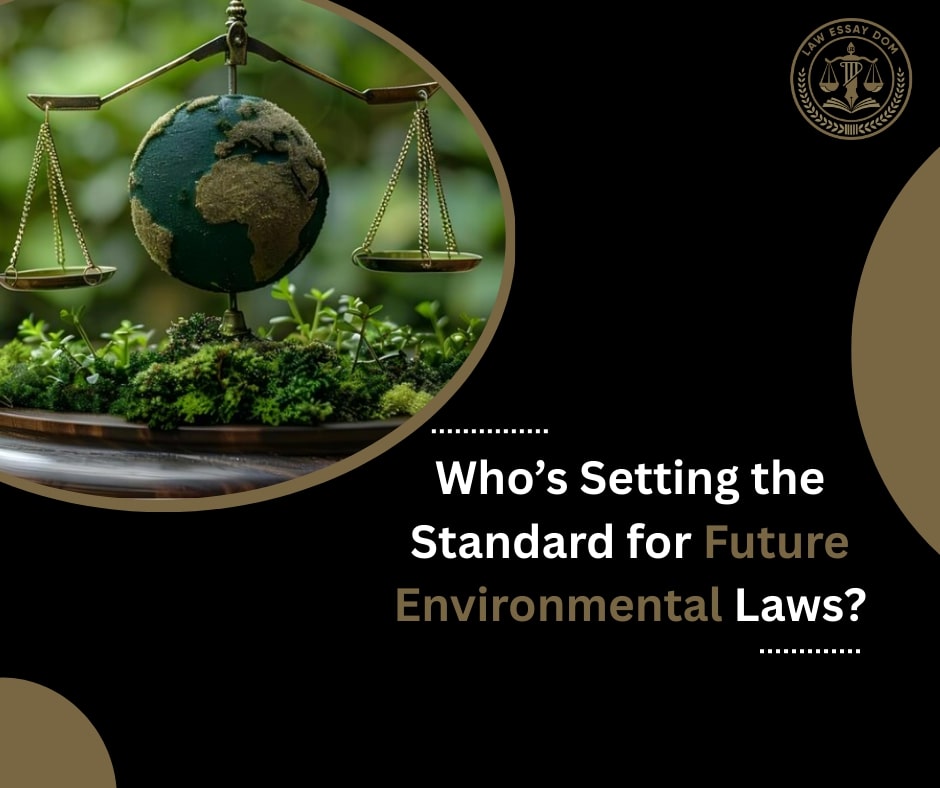As the climate crisis worsens, green laws are rapidly emerging as vital tools worldwide, driving swift reforms in pollution, biodiversity, and resource management regulations. Prompted by lofty goals of net-zero by 2050 and Paris Agreement targets. But a very basic question emerges: Who is actually setting the standard for upcoming environmental legislation?Well, you can always turn to law coursework help UK for a better comprehension, particularly if you’re examining intricate themes like the law of assumption, commutative law, or law of detachment.
You can also refer to this guide as this blog delves into the world’s influences. The strictest country in the world, legislative leaders, and policy trends, specifically looking at the UK’s changing role in crafting a greener future.
Global Drivers of Environmental Law
A lot of modern environmental law is influenced by cooperation and agreement between nations. The UN Framework Convention on Climate Change and the Paris Agreement thus ensure that different parties. Conduct activities with the intention of reducing greenhouse gas emissions and halting and averting other effects of global warming.
The recent greatest milestone of Europe’s Green Deal will bring Europe to be the first continent to achieve climate neutrality by 2050. It has brought comprehensive legislation regarding everything from carbon taxes to supply chains.
Likewise, the United Nations Environment Programme (UNEP) has a critical role to play in assisting nations in applying environmental law. It offers legal advice and helps countries establish national laws consistent with international environmental objectives. Something law apprentices may learn extensively at institutions such as Davisons Law, Admiral Law, or even Minster Law, which practice different areas of law, including environmental and public law.
The UK’s Environmental Law Framework Post-Brexit
In the aftermath of Brexit, the UK needed to follow the trajectory of building an independent environmental legal identity. The Environment Act 2021 served as the foundation of this new direction. It set legally binding environmental goals on air quality, water, waste reduction, and biodiversity conservation. Placing the long-term sustainability pledges of the UK on a stronger basis.
The Office for Environmental Protection (OEP) is one of the most important institutions mandated by the act. The OEP will oversee environmental progress, offer advice to the government, and hold public authorities to account when environmental law is breached.
Devolved governments also have a key role. Scotland’s Environmental Strategy, Wales’s Well-being of Future Generations Act, and Northern Ireland’s Environmental Governance Framework all make green policy more tailored in local terms. Displaying the UK’s multi-faceted approach to environmental governance. This changing scene also provokes contemplation of how environmental law may intersect with some of the highest paying Law fields.
Leading Nations and Regions Setting the Bar
In the sphere of environmental law innovation, various nations take pride of place:
- The European Union itself is generally perceived as being world-leading, not only by way of its Green Deal but also through the EU Emissions Trading System (ETS). It is one of the largest carbon markets in the world. The block’s strict green regulations frequently lead UK businesses making cross-border deals. Many of which turn to firms such as Acuity Law or Capital Law for advice on compliance.
- Scandinavian nations like Sweden and Denmark routinely lead environmental performance rankings. Their regulatory systems encourage circular economies, incentives for renewable energy, and zero-waste policies.
- Within the U.S, while nationwide trends vary, states such as California have implemented some of the most ambitious world climate laws. California’s cap-and-trade program and car emissions regulations are frequently used as blueprints worldwide.
- Unexpected leaders have also appeared. Costa Rica, for instance, operates nearly entirely on renewable resources and has integrated environmental safeguards into its constitution. Bhutan, the world’s sole carbon-negative nation, requires environmental sustainability in every policy choice.
Corporate Influence and Legal Innovation
Environmental law is no longer limited to public regulation. The corporate sector is constantly open to legal scrutiny of its environmental footprint. Environmental, Social, and Governance (ESG) standards have become the corporate law priority, specifically in the UK’s investment and financial sectors.
A landmark was achieved in 2021 when a Dutch court ordered Royal Dutch Shell to reduce its carbon footprint—a first-of-its-kind precedent in the law that shook the corporate establishment. The case showed how climate litigation is becoming an effective way of forcing environmental accountability.
Even fictional portrayals like the cast of Law and Order: Organised Crime or Law and Order: True Crime reflects how legal battles shape public opinion on corporate responsibility and environmental ethics.
There is new legislation also for combating greenwashing, in which companies make misleading environmental assertions. The Competition and Markets Authority (CMA) in the UK has initiated investigations into several brands under its Green Claims Code in an effort to protect consumers.
Technological and Social Forces Shaping Policy
Today’s environmental law is not only informed by governments—it’s more and more shaped by data, technology, and public sentiment.
Artificial intelligence and big data are being utilised to monitor emissions, track biodiversity, and predict environmental hazards. These data inform legislators to craft more adaptable and evidence-driven policies.
Concurrently, social activism remains a chief impetus. Activists such as Greta Thunberg and organizations such as Extinction Rebellion have brought climate justice onto national agendas. In the UK, actions by Friends of the Earth have stopped infrastructure projects and shaped air quality policy.
Notably, young people-led court cases are also picking up pace. The world’s explosion in youth climate lawsuits mirrors the trend of more and more citizens forcing governments to act to provide adequate environmental safeguards. This movement is also giving rise to school movements resources such as Law Teacher make such legalities simpler for students.
The Role of Courts and Climate Litigation in Shaping the Law
While legislators craft laws and governments prepare policies, courts everywhere are being asked more and more frequently to interpret, enforce, and, in some instances, broaden the reach of environmental law.
Judicial Activism on Climate Issues
In recent years, there are a lot of climate issues in different parts of Europe, North America, and the South. Courts are not only holding governments but also corporations accountable for their climate-induced harm.
Indeed, a case in point is the Urgenda Foundation v. State of the Netherlands. The Netherlands Supreme Court held that the government was bound by law to decrease emissions as part of fulfilling its human rights law commitment. The case was a milestone in the crossroads between environmental and human rights law, and it focused on the increased role of the human rights lawyer in dealing with climate change through the legal framework.
It is a case that set a precedent beyond the costs of the Netherlands and led to similar lawsuits in Germany, France, and Belgium.
The UK’s Legal Landscape
In the UK, too, climate litigation is increasing. Client Earth, a charity specializing in environmental law, launched a landmark suit against Shell’s directors in 2022 for purportedly breaching their legal duties by failing to adopt a climate strategy aligned with the Paris Agreement.
Although still ongoing, the case points to a new front of law: making individual board members liable for climate risk. If it succeeds, it could lead to similar action in both the UK and internationally.
UK courts have also made their opinions known on environmental issues, from Law One Piece-style heroic tales in activism to actual infrastructure projects, such as Heathrow’s third runway and oil exploration proposals, all subject to judicial review over climate issues.
International Ripple Effects
What occurs in a single courtroom may have ripple effects around the world. Judicial conclusions—particularly of supreme or constitutional courts—will frequently prompt other jurisdictions to deliver similar legal findings. This interjurisdictional legal conversation is becoming an invisible but influential dynamic in harmonising and raising standards of environmental law.
What the Future Holds for UK Environmental Law
The law of the UK is transforming at pace, with a range of trends pushing towards an increasingly progressive and aspirational future.
Among the major themes is the circular economy—a closed system where resources are cycled, reused, and not discarded. A new law on the proposed books will observe more producer responsibility, reduce plastic waste, and encourage sustainable product design.
Another milestone is biodiversity net gain, a policy whereby new projects are to be looked upon as having to enhance positively the natural environment. Starting in January 2024, it will be legally enforceable in England. Would have a massive impact on how construction and infrastructure projects are conceived and planned. Property companies such as Convey Law already have plans underway to accommodate this shift in planning legislation.
Green finance is also gaining momentum. The UK Green Taxonomy, to be introduced in stages, will define what qualifies as an environmentally sustainable activity for investors. This classification system is expected to shape how banks and corporations direct capital—an evolving area that continues to generate interest in law assignment help, particularly for students exploring the intersection between environmental law and global finance.
Finally, climate adaptation and resilience legislation is likely to grow in importance. With rising threats from extreme weather, the law will increasingly address flood risk management, urban heat mitigation, and ecosystem restoration.
Conclusion
So, who’s leading the way in setting the standard for future environmental legislation? The answer is not one. It’s a collective tapestry created by international institutions, innovative nations, visionary activists, forward-looking businesses, and emerging technologies.
While the EU continues to lead the charge with hostile regulatory approaches, Scandinavia provides moral and practical examples. Law and Order UK, albeit struggling post-Brexit, is forging its own legislative direction—one that marries environmental aspiration with legal accountability.
The future of green law will rely not only on political will but also on cross-border cooperation. If the UK maintains its trend of prioritizing the environment and aligning its legal systems with science and sustainability, it might not only follow international trends but set the pace itself.

 +44 7441 427073
+44 7441 427073  +44 7441 427073
+44 7441 427073 


